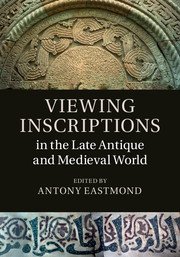Antony Eastmond, ed. Viewing Inscriptions in the Late Antique and Medieval World. Cambridge University Press, 2015
From Cambridge University Press
Inscriptions convey meaning not just by their contents but also by other means, such as choice of script, location, scale, spatial organisation, letterform, legibility and clarity. The essays in this book consider these visual qualities of inscriptions, ranging across the Mediterranean and the Near East from Spain to Iran and beyond, including Norman Sicily, Islamic North Africa, Byzantium, medieval Italy, Georgia and Armenia. While most essays focus on Late Antiquity and the Middle Ages, they also look back at Achaemenid Iran and forward to Mughal India. Topics discussed include real and pseudo-writing, multilingual inscriptions, graffiti, writing disguised as images and images disguised as words. From public texts set up on mountainsides or on church and madrasa walls to intimate craftsmen's signatures, barely visible on the undersides of precious objects, the inscriptions discussed in this volume reveal their meanings as textual and visual devices.
Contents:
Introduction: viewing inscriptions
Antony Eastmond
Text, image, memory, and performance: epigraphic practices in Persia and the ancient Iranian world
Matthew P. Canepa
Prayers on site: the materiality of devotional graffiti and the production of early Christian sacred space
Ann Marie Yasin
Erasure and memory: Aghlabid and Fatimid inscriptions in North Africa
Jonathan Bloom
Textual icons: viewing inscriptions in medieval Georgia
Antony Eastmond
Pseudo-Arabic 'inscriptions' and the pilgrim's path at Hosios Loukas
Alicia Walker
Arabic inscriptions in the Cappella Palatina: performativity, audience, legibility, and illegibility
Jeremy Johns
Intercession and succession, enlightenment and reflection: the inscriptional and decorative program of the Qaratay Madrasa, Konya
Scott Redford
Remembering Fernando: multilingualism in medieval Iberia
Tom Nickson
Displaying the word: words as visual signs in the Armenian architectural decoration of the monastery of Noravank (fourteenth century)
Ioanna Rapti
Written in stone: civic memory and monumental writing in the Cathedral of San Lorenzo in Genoa
Stefania Gerevini
Place, space, and style: craftsmen's signatures in medieval Islamic art
Sheila S. Blair
Afterword: re-viewing inscriptions
Antony Eastmond

